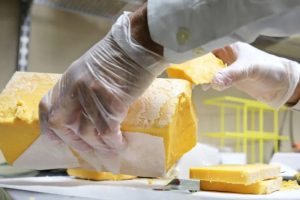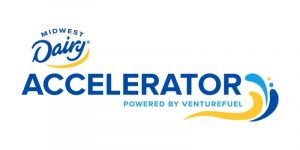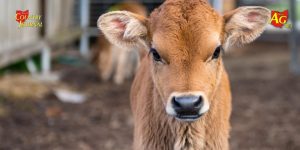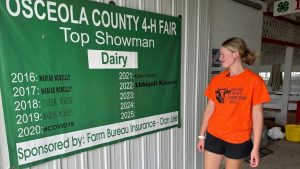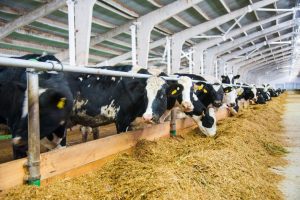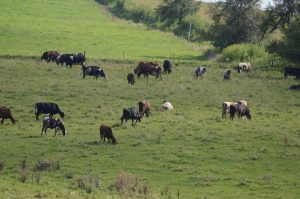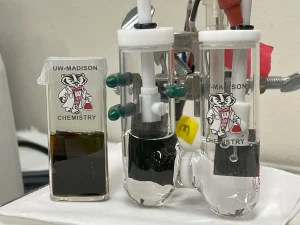
A large feedlot near Watertown with about 10,000 cattle was recently disciplined for not properly managing its manure.
But not by the state.
It was the Codington County Board of Adjustment that responded to public complaints. The board found the operation violated 25 zoning ordinances or permit requirements. As a result, the board decided to implement a range of sanctions — including mandatory downsizing to 7,500 cattle in hopes of lessening the strain on waste management systems, according to Luke Muller, the county zoning officer.
“There were several violations of spreading manure too close to water sources, roads and property lines, and stockpiling it improperly in an unauthorized area,” Muller said. “And the county can modify that permit.”
Muller said the county decided to take action rather than forwarding the findings to the state, because the operation was in violation of specific county rules.
“Had the complaints been in regard to pollution of waters of the state or wetlands, those complaints would have been forwarded on to the SDDANR office for their interpretation,” Muller said in a written statement, in reference to the South Dakota Department of Agriculture and Natural Resources. “In this case, there was no need to get an interpretation from the state on whether the county’s rules were being violated prior to addressing the violations.”
Muller added that the Board of Adjustment did forward a report to ensure the state is aware of the violations and to request assistance in reviewing whether waste is being managed in accordance with state rules, specifically in reference to water quality.
Regulation by size
Concentrated Animal Feeding Operations — often referred to by the acronym “CAFO” — are required by state law to operate under a water pollution control permit once they reach a certain size.
South Dakota law says state environmental regulations cannot be more strict than federal regulations. That means what federal agencies regulate is what the state regulates.
Therefore, state regulations primarily focus on large concentrated animal feeding operations, which all need a permit. Those thresholds include 700 dairy cows, 1,000 cattle, 2,500 pigs and 125,000 chickens.
Medium CAFOs only need a permit if their waste is discharged into a body of water regulated by the state (think rivers, lakes and other waterbodies named on a map). Those operations include 200- to 699-cow dairies, 300- to 999-cattle feedlots, 750- to 2,499-pig swine barns, and 37,500- to 124,999-chicken poultry barns.
Small CAFOs need a permit only if required by the secretary of the Department of Agriculture and Natural Resources. Those operations include dairies with less than 200 cows, feedlots with less than 300 cattle, swine barns with less than 750 pigs, and poultry barns with less than 37,500 chickens.
Walsh said in a written statement that there are currently three small animal feeding operations that have been required to obtain a water pollution control permit. He said the secretary sometimes decides to require a permit after receiving a complaint about a small facility.
“Those animal limits are being taken advantage of by some to avoid regulation,” James said.
He finds it foolish that an operation with one less pig, cow or chicken than the regulatory threshold does not need a permit. He also thinks the state should be more proactive with enforcement.
“It’s a complaint-based system,” James said. “The only way the state hears about a problem is if someone in the public complains. It’s all just paperwork in the state’s eyes.”
“We have dozens of these facilities that are within a mile of the Big Sioux River or a tributary and they’re not managing their waste,” Roberts said.
Complaining about such facilities became harder during the most recent legislative session. Legislators passed a law that says only the owner or lessee of an affected property can file a nuisance action against an agricultural operation such as a CAFO, and only if the affected property is within 1 mile of the operation.
Numbers growing
The number of hogs in CAFOs the state regulates climbed from about 605,000 in 2012 to 841,000 in 2023. The number of dairy cows in regulated CAFOs more than doubled in the last decade, and the number of poultry rose from about 4.4 million to 5.7 million.
In 2015, he sponsored a bill that made it easier for CAFOs to get approval from counties. The following year, he got a bill passed that opponents argued would limit the public’s ability to appeal a county’s approval of a CAFO.
Dakota Rural Action and the South Dakota Farmers Union lobbied against those efforts, arguing they made it harder for rural communities to address concerns with a CAFO.
Mickelson and other proponents — like the Farm Bureau and livestock groups — argued CAFOs deserve greater protection from frivolous lawsuits and opponents hostile to the industry. They argued bringing more CAFOs to South Dakota was good for two primary reasons: giving South Dakota ag producers another revenue stream and establishing a greater local supply of livestock and poultry for the state’s major processors.
“They have to do a lot of things that smaller operations do not have to do,” he said, adding, “because they are so heavily regulated, they’re very well managed.”
Thaler said large operations can create jobs, increase local tax revenues and grow profits for operators.
“If you can triple the size of a family farm and that’s OK, why can’t you triple the size of your livestock operation and take advantage of the same purchasing power and efficiencies that you can on the agronomy side?” he said.





